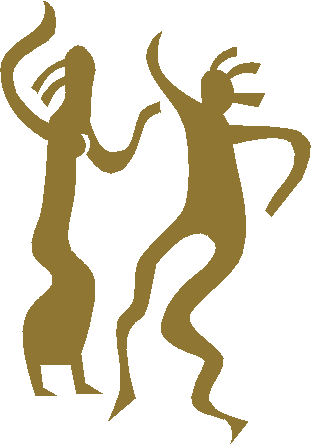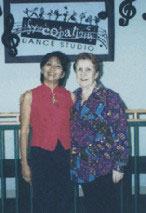You are here: Victoria's
Dance Secrets > Introduction
INTRODUCTION
 I
STUMBLED UPON Ms. Skippy Blair's innovative Universal Unit System of Dance Education and
Annotation through a niece while vacationing in Los Angeles in June 1997. Jenni
Cabrera belatedly remembered she still had a reference book from her social dance class at
the University of California a few years back, and showed it to me. I had discovered a
gold mine. I
STUMBLED UPON Ms. Skippy Blair's innovative Universal Unit System of Dance Education and
Annotation through a niece while vacationing in Los Angeles in June 1997. Jenni
Cabrera belatedly remembered she still had a reference book from her social dance class at
the University of California a few years back, and showed it to me. I had discovered a
gold mine. 
Ms. Blair brought me back to the root of all
dance. I tried to absorb everything I could from her 3-hour class which focused on the
Waltz, prompting me to recall the "down-up-up" movement of the classic dance.
She clearly explained the logical mechanics of the movement, which I had forgotten, and
merely assumed.
Hers was such a refreshingly appealing
approach to learning dance, very much like an adult literacy class. The session was
a teachers' class but the approach could easily be replicated for beginners. A very
similar approach is now used by the Heritage Dance Center.
Ms. Blair's Universal Unit System is the
basis for the dance annotations in this book but are by no means limited to her
annotations. As with the dance principles and techniques shared here, many of the dance
patterns are a compendium of researches from various sources, observations of step
variations and sequences used in the Philippines, and the author's personal experiences,
discoveries and analyses.
This book is for the Amateur Dancer who will
soon realize that dancing is really easy to learn once they discover the rules. It in not
necessary to keep in stock an endless number of variations. More important is the graceful
and confident execution of even just the few basic patterns of each dance. As
Ms. Blair says: "Its not a crime to be a beginner, but it sure is a
crime to look like one." In the end, even the beginner dancer can be
a choreographer for his own purpose and for entertainment.
It is also for the Professional Dancer who
wishes to rediscover the underlying principles, techniques and rules of movement and music
applicable to all dances. Hopefully this book can help them become better dancers,
teachers, trainers, and choreographers.
We at the Heritage Dance Center believe that
every dancer can be creative if given the proper tools to work with. This whole book
provides those tools for every dancer to use. The dancer is encouraged to create his own
step sequences using the basic step patterns of the dance, and substitute appropriate
rhythms or syncopate when applicable. You will be amazed at how many different original
sequences you can create from the patterns provided.

|
